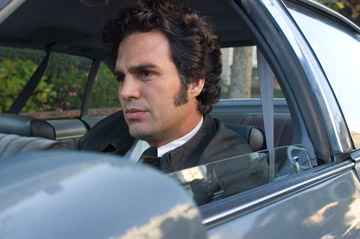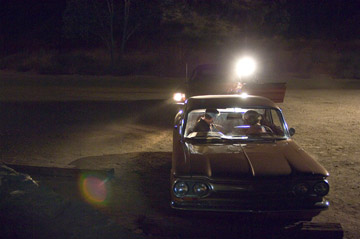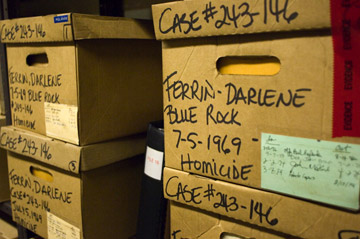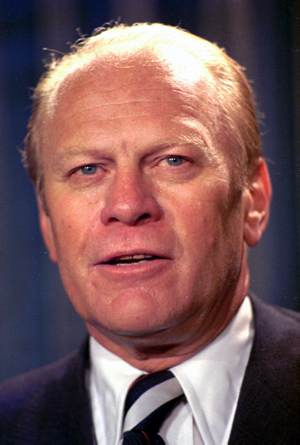In a document dump of both exhilarating and terrifying proportions, the CIA announced it will release its “family jewels” next week: close to 700 pages of documents chronicling secret Agency activity from the fifties to the seventies. (A preview of what’s to come includes reports of detentions, wiretapping, surveillance, and other sordid current administration favorites.) “CIA Director Michael Hayden on Thursday called the documents being released next week unflattering, but he added that ‘it is CIA’s history.’ ‘The documents provide a glimpse of a very different time and a very different agency,’ Hayden told a conference of historians.” Hmm, we’ll see.
Category: The Seventies
Greenberg/Morgan.
“Morgan’s grasp of Nixon’s place in American culture is confirmed near the play’s end, when Reston endorses an opinion that one seldom hears in routine journalistic commentary but that I believe is undoubtedly true: Nixon was never rehabilitated. He never came back. Despite the pomp and fine words at his funeral, his name remained a synonym for presidential corruption and crime, and the ‘-gate’ suffix attached to scandals ever since certified Watergate’s cultural importance” Rutgers professor and author of Nixon’s Shadow David Greenberg reviews Frost/Nixon for Slate.
Sign of the Beast.
 More a straightforward police procedural than the type of visually kinetic extravaganza one might expect from the director of Se7en and Fight Club, David Fincher’s Zodiac, which I saw on Friday, is a slow-moving but generally effective film. I confess to having very little interest in the story of the Zodiac killer, or in serial killer movies in general. Still, I found Zodiac to be a somber and engaging character study of the cops, journalists, and suspects caught up in the hunt for San Francisco’s most famous murderer, and a moody meditation on how, as months yield to years without a definitive answer, the long, tiring search for truth comes to haunt and drain their lives away. It may basically play like a seventies throwback Law and Order for most of its run, with occasional flourishes from The Wire, but Zodiac is still a worthwhile film, and one that marks a welcome rebound for Fincher after the relatively uninspired Panic Room. It’s good to see his sign rising once again.
More a straightforward police procedural than the type of visually kinetic extravaganza one might expect from the director of Se7en and Fight Club, David Fincher’s Zodiac, which I saw on Friday, is a slow-moving but generally effective film. I confess to having very little interest in the story of the Zodiac killer, or in serial killer movies in general. Still, I found Zodiac to be a somber and engaging character study of the cops, journalists, and suspects caught up in the hunt for San Francisco’s most famous murderer, and a moody meditation on how, as months yield to years without a definitive answer, the long, tiring search for truth comes to haunt and drain their lives away. It may basically play like a seventies throwback Law and Order for most of its run, with occasional flourishes from The Wire, but Zodiac is still a worthwhile film, and one that marks a welcome rebound for Fincher after the relatively uninspired Panic Room. It’s good to see his sign rising once again.
 After the first of many impressive establishing shots of San Francisco, set to some spooky post-psychedelic pop ditty of the era, Zodiac begins on July 4th, 1969, with what feels like both a classic urban legend and a recipe for disaster — two young people flirting and fumbling at a dark and abandoned Lover’s Lane. Only this story is true, and soon enough, the Zodiac has struck for the second time, leaving one dead and another terribly wounded in his wake. Showing a penchant for publicity that will make him a household name in the Bay Area over the next few years, the Zodiac sends both boastful and encoded message to several major newspapers. These pique the interest of — among others — a hard-drinking, hard-living writer on the cop beat (Robert Downey, Jr.), a nebbishy cartoonist with a knack for puzzles (Jake Gyllenhaal, playing the author of the book on which the film is based), and two peace officers (Mark Ruffalo, Anthony Edwards) assigned to track down this preening sociopath before he strikes again. For the next few years, we follow each of these fellows as they attempt to pin down the identity of the elusive killer: negotiating bureaucratic snafus, parsing encrypted texts, and, yes, hitting the archives like good, little researchers. But the trail of the Zodiac exacts a heavy toll, and as the Age of Aquarius fades into the Reagan era, each of these men leave the decade scarred by their quest, some irreparably. And still, somewhere out there, the Zodiac lurks…
After the first of many impressive establishing shots of San Francisco, set to some spooky post-psychedelic pop ditty of the era, Zodiac begins on July 4th, 1969, with what feels like both a classic urban legend and a recipe for disaster — two young people flirting and fumbling at a dark and abandoned Lover’s Lane. Only this story is true, and soon enough, the Zodiac has struck for the second time, leaving one dead and another terribly wounded in his wake. Showing a penchant for publicity that will make him a household name in the Bay Area over the next few years, the Zodiac sends both boastful and encoded message to several major newspapers. These pique the interest of — among others — a hard-drinking, hard-living writer on the cop beat (Robert Downey, Jr.), a nebbishy cartoonist with a knack for puzzles (Jake Gyllenhaal, playing the author of the book on which the film is based), and two peace officers (Mark Ruffalo, Anthony Edwards) assigned to track down this preening sociopath before he strikes again. For the next few years, we follow each of these fellows as they attempt to pin down the identity of the elusive killer: negotiating bureaucratic snafus, parsing encrypted texts, and, yes, hitting the archives like good, little researchers. But the trail of the Zodiac exacts a heavy toll, and as the Age of Aquarius fades into the Reagan era, each of these men leave the decade scarred by their quest, some irreparably. And still, somewhere out there, the Zodiac lurks…
 Its opening moments notwithstanding, most of Zodiac is concerned not with nasty serial killer exploits (although there are a few, such as a jarring afternoon picnic at the lake) but the ugly mechanics of the cops and journalists’ search, with all its circumstantial theorizing and bureaucratic gear-grinding. Some of this stuff, such as the memory-holes that arise between overlapping jurisdictions of various Bay Area law enforcement bureaus, would probably seem fresher if you’ve never watched The Wire, where police mismanagement and careerism is a central staple. (That being said, likable character actors like Elias Koteas, Donal Logue, and Zach Grenier spice up these scenes considerably.) But, other facets of the hunt still resonate, such as how multiple explanations pile up for a given clue with no real way to determine the correct one. The Zodiac’s symbol…is it a cross-hair, or was it stolen from a watch company, or is it the countdown from the opening of a film reel? Each answer seems like it must be the definitive one at different times, and, for the participants in this haunted search, the shifting interpretations grow increasingly maddening. The film is kind enough to give the audience something of a sense of closure at the end, but Zodiac is most intriguing when it leaves all doors open, and lets its characters get thrown about in the bruising wind that ensues.
Its opening moments notwithstanding, most of Zodiac is concerned not with nasty serial killer exploits (although there are a few, such as a jarring afternoon picnic at the lake) but the ugly mechanics of the cops and journalists’ search, with all its circumstantial theorizing and bureaucratic gear-grinding. Some of this stuff, such as the memory-holes that arise between overlapping jurisdictions of various Bay Area law enforcement bureaus, would probably seem fresher if you’ve never watched The Wire, where police mismanagement and careerism is a central staple. (That being said, likable character actors like Elias Koteas, Donal Logue, and Zach Grenier spice up these scenes considerably.) But, other facets of the hunt still resonate, such as how multiple explanations pile up for a given clue with no real way to determine the correct one. The Zodiac’s symbol…is it a cross-hair, or was it stolen from a watch company, or is it the countdown from the opening of a film reel? Each answer seems like it must be the definitive one at different times, and, for the participants in this haunted search, the shifting interpretations grow increasingly maddening. The film is kind enough to give the audience something of a sense of closure at the end, but Zodiac is most intriguing when it leaves all doors open, and lets its characters get thrown about in the bruising wind that ensues.
Ground Control to Justice Bill.
Newly released — and somewhat controversial — FBI files, dating from the former Chief Justice’s two confirmation battles in 1971 and 1986, disclose that William Rehnquist battled a painkiller addiction in the early ’80s while serving on the Court. “Doctors interviewed by the FBI told agents that when the associate justice stopped taking the drug, he suffered paranoid delusions. One doctor said Rehnquist thought he heard voices outside his hospital room plotting against him and had ‘bizarre ideas and outrageous thoughts,’ including imagining ‘a CIA plot against him’ and ‘seeming to see the design patterns on the hospital curtains change configuration.’ At one point, a doctor told the investigators, Rehnquist went ‘to the lobby in his pajamas in order to try to escape.’“
Nixon versus the Diplomats.
Also among the intriguing recent disclosures of the Nixon years are newly released State Department records which reveal further Nixon’s contempt for his Foreign Service. “Just before saying he was going ‘to take the responsibility for cleaning up’ the department, the president told Kissinger on November 13 that he was determined that ‘his one legacy is to ruin the Foreign Service. I mean ruin it — the old Foreign Service — and to build a new one. I’m going to do it.’“
Model Ford.
“As President, my primary concern must always be the greatest good of all the people of the United States whose servant I am. As a man, my first consideration is to be true to my own convictions and my own conscience. My conscience tells me clearly and certainly that I cannot prolong the bad dreams that continue to reopen a chapter that is closed. My conscience tells me that only I, as President, have the constitutional power to firmly shut and seal this book.” Gerald Ford, 1913-2006.
Northern Exposure?
“Historically, the major parties in America have yoked together the most disparate groups for long periods. The New Deal Democrats were a party of Northern liberals and Southern segregationists. But once Lyndon Johnson committed the Democrats to civil rights for African Americans, the white South up and left — a process that took 40 years to complete but that left the Democrats struggling to assemble congressional and presidential majorities and that converted the Republicans into a party where Southern values were dominant. Now the non-Southern bastions of Republicanism may themselves up and leave the GOP, seeing it as no longer theirs.” The American Prospect‘s Harold Meyerson sees potential for a realignment of northern moderates come Tuesday. Well, let’s hope. Chafee looks like toast (and he’s acting like it, too), but there are still a lot of undecideds — between 15 and 20% — in that Rhode Island race. And, lest we forget, our very own president, much as he’d like us to think otherwise, is a scion of the North as well.
The Flowering of Magnolia Conservatism.
“Lyndon Johnson was probably right to fret about the political consequences of civil rights. And even he, who knew more about the intricacies of Southern politics than any 20th-century president, could not have known how complicated the future would be.” By way of Cliopatria, Jefferson Decker, a former managing editor of Boston Review and one of my friends and colleagues here at Columbia, takes a look at two new books on the rise of the Republican Party in the South: Kevin Kruse’s White Flight: Atlanta and the Making of Modern Conservatism and Matthew Lassiter’s The Silent Majority: Suburban Politics in the Sunbelt South.
Four dead in Ohio.
As seen at Blivet: On the thirty-sixth anniversary of the shootings, wood s lot remembers Kent State. (And, since it gets so much less press, let’s not forget the tragedy at Jackson State ten days later.)
Worst President Ever?
“Calamitous presidents, faced with enormous difficulties — Buchanan, Andrew Johnson, Hoover and now Bush — have divided the nation, governed erratically and left the nation worse off. In each case, different factors contributed to the failure: disastrous domestic policies, foreign-policy blunders and military setbacks, executive misconduct, crises of credibility and public trust. Bush, however, is one of the rarities in presidential history: He has not only stumbled badly in every one of these key areas, he has also displayed a weakness common among the greatest presidential failures — an unswerving adherence to a simplistic ideology that abjures deviation from dogma as heresy, thus preventing any pragmatic adjustment to changing realities.” As seen all over the place, historian Sean Wilentz wonders aloud in Rolling Stone if Dubya is the worst president in American history.
To my mind, the only other president that even comes close is James Buchanan. Sure, Warren Harding was lousy, but he knew it (“I am a man of limited talents from a small town. I don’t seem to grasp that I am President.“), and thus didn’t go out of his way to be actively terrible like Bush has been. (Plus, for all the corruption of the Ohio gang, Harding’s cabinet also included Charles Evans Hughes, Andrew Mellon, and Herbert Hoover, all impressive in their own right.) Speaking of Hoover, both he and Ulysses Grant have been given a bad shake. Even if the Depression basically ate his administration alive, Hoover — once renowned as the “Great Engineer” — was a more innovative president (and empathetic person) than he’s often remembered. And Grant’s administrations, although plagued by corruption, at the very least tried to maintain Reconstruction in the South. (In fact, I’d argue that Grant’s sorry standing in presidential history is in a part a reflection of the low esteem in which Reconstruction was once held by the now-woefully obsolete Dunning School.) Regarding the other Reconstruction president, Andrew Johnson is assuredly down near the bottom too, but to be fair, he faced an almost impossible situation entering office in the time and manner he did, and — as with Clinton — his impeachment was a bit of a frame-job. And Richard Nixon, for all his many failings, had China (as well as the EPA despite himself, and, although it didn’t pan out, the Family Assistance Plan.) Nope, I think it’s safe to say that we may be experiencing perhaps the most blatantly inept, wrong-headed, and mismanaged presidency in the history of the republic. Oh, lucky us.

